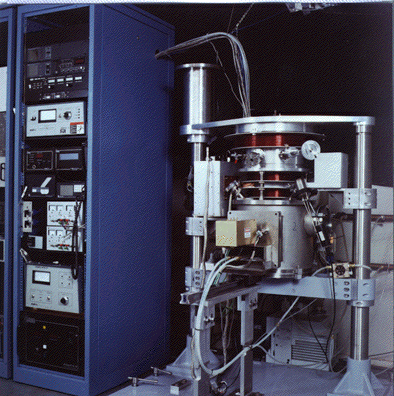
The SP3 laboratory developed a new environmentally clean thin film deposition system using electron beam evaporation of solid to produce gas phase species instead of dangerous halides, hydrides or organometallics.

The Helicon Activated Reactive Evaporation (HARE) is a plasma assisted reactive evaporation device that combines an evaporation source (electron-beam evaporator) and a high density plasma source (Helicon plasma source), in a configuration in which the evaporant material is transported through the plasma source. Plasma enhancement of a simple electron-beam vapour deposition system can have a number of desirable effects. Through the ionisation process, plasmas deliver an energetic flux of particles to the substrate, assisting the bonding of coating material and the uniformity in film growth. The energetic flux can be controlled by applying a bias (dc or rf) to the substrate. In the present configuration, the plasma has the additional effects of assisting chemical reactions, by dissociating the gas phase, thus enhancing the reactivity of the gas.
A schematic of the HARE
The Helicon Activated Reactive Evaporation (HARE) system combines the advantage of reactive evaporation and of plasma assisted deposition. The plasma has a strong direct influence on the properties of the deposited film and also affects the generation of the precursors to the deposition, and their transport onto the substrate. Furthermore, this configuration exhibits the advantage of preserving the symmetrical geometry of the apparatus, which can be an advantage when processing symmetrical substrates such as silicon wafers in microelectronics.
A completely successful proof of concept with excellent quality SiO2 layers deposited has been achieved.
 SiO2 film deposited on Si substrate in an O2 plasma, and Infra-Red transmission spectra.
SiO2 film deposited on Si substrate in an O2 plasma, and Infra-Red transmission spectra.
Virtually any material can be evaporated and, with the Helicon source, new exotic thin films can be fabricated. A first step is being made towards germanium doping of silica for non-linear optical devices.
By using a specially designed pulsed high-voltage power supply, ions from the plasma can be attracted and implanted into wafers. Initial experiments have shown that germanium ions can be implanted into crystalline silicon wafers at high doses. This novel system provides a very cost effective way of implanting large areas very quickly without using expensive ion accelerators.
For the first time, a plasma of pure germanium has been created. Its properties appear significantly different to other gaseous plasmas created in the same system and the basic physics of the system are being studied. An ultra high vacuum HARE system has been constructed for the deposition of silicon/germanium films for very high speed microelectronics applications. Patents have been taken out on the latter two research areas. The laboratory designed, built and installed a similar system at the University of Sydney where cubic boron nitite is being deposited.
Analytical models have been developed and used with the experimental measurements of the diffusion of the beam of evaporant through Argon and Hydrogen to obtain absolute cross sections for Si-Ar and Si-H2 collisions. Work is proceeding on the full modelling of the diffusion using a 2D hybrid plasma code which will yield the ionization efficiency of the system and the species mix of particles arriving at the wafer. It is interesting to note that basic physical properties can be discovered in the process of developing an industrial system.
A pure silicon plasma has been obtained in HARE
The HARE has been used for producing new materials that have applications in integrated optics. We have produced silica films doped with germanium which are photosensitive and can be used for direct writing of optical waveguides.
The HARE is commercially available from ENYA Systems Ltd